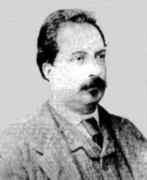Person: Beltrami, Eugenio

Eugenio Beltrami contributed to work in differential geometry on curves and surfaces and gave a concrete realisation of the non-euclidean geometry.
Mathematical Profile (Excerpt):
- Beltrami studied at Pavia from 1853 to 1856, and there he was taught by Brioschi who had been appointed as professor of applied mathematics at the University of Pavia the year before Beltrami began his studies.
- Beltrami would have liked to continue his mathematical studies but he was suffering financial hardship so in 1856 he had to stop his studies and take up a job.
- While Beltrami was in Milan the Kingdom of Italy was established in 1861.
- At Milan Beltrami began to work hard at his mathematical studies again and in 1862 he published his first paper.
- After two years in Bologna, Beltrami accepted the chair of geodesy at the University of Pisa, which he held from 1864 to 1866.
- A new University of Rome was set up in the new Italian capital and Beltrami was appointed to the chair of rational mechanics there in 1873.
- After three years in Rome, Beltrami moved to Pavia to take up the chair of mathematical physics there.
- However, Beltrami returned to Rome in 1891 and spent his last years teaching there.
- Influenced by Cremona, Lobachevsky, Gauss and Riemann, Beltrami contributed to work in differential geometry on curves and surfaces.
- Beltrami showed that not all geodesics could be represented in this way and he then went on to consider the natural question of which surfaces had the property that geodesics on the surface could be represented as straight lines on the plane.
- Beltrami then considered surfaces of constant negative curvature and was led to his most famous results of 1868.
- Beltrami in this 1868 paper did not set out to prove the consistency of non-Euclidean geometry or the independence of the Euclidean parallel postulate.
- Houel translated both Lobachevsky's and Beltrami's work into French in 1870 and he noted how Beltrami's paper proved the independence of the Euclid's parallel postulate.
- Cremona was wrong, but his worries caused Beltrami to put his work on one side for a while but the work of Riemann convinced Beltrami that his methods were sound.
- Beltrami also worked on optics, thermodynamics, elasticity, electricity and magnetism.
- Beltrami indirectly influenced the development of tensor analysis by providing a basis for the ideas of Ricci-Curbastro and Levi-Civita on the topic.
- Some of Beltrami's last work was on a mechanical interpretation of Maxwell's equations.
- Here, Beltrami showed a new proof of the conditions when six given functions are the components of an elastic deformation.
- Finally we should mention an important contribution by Beltrami to the history of mathematics.
- This appears in a 1889 publication in which Beltrami brought to the attention of the mathematical world Saccheri's 1733 study of the parallel postulate.
- Beltrami achieved an important role in Italian mathematics, becoming President of the Accademia dei Lincei in 1898.
Born 16 November 1835, Cremona, Lombardy, Austrian Empire (now Italy). Died 18 February 1900, Rome, Italy.
View full biography at MacTutor
Tags relevant for this person:
Geometry, Origin Italy
Thank you to the contributors under CC BY-SA 4.0! 

- Github:
-

- non-Github:
- @J-J-O'Connor
- @E-F-Robertson
References
Adapted from other CC BY-SA 4.0 Sources:
- O’Connor, John J; Robertson, Edmund F: MacTutor History of Mathematics Archive
